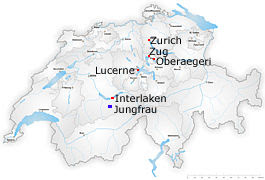
This map shows the main centres we visited during the week we spent in Switzerland. Besides Oberägeri we also explored Zug, Lucerne, the Jungfrau mountain and Zurich.

On Sunday 26 November 2007, after the walk at Raten Pass, we drove down to Zug for lunch at the Duomus, followed by a stroll through the old city and along the lake front.

We loved the chestnut trees in abundance along the waterfront and also enjoyed some piping hot, freshly roasted chestnuts sold on the spot.
The town of Zug (pronounced tsoogk), 22km from Lucerne on the north side of the Rigi, is the richest place in Switzerland, which makes it very rich indeed. Tiny Canton Zug has the lowest tax rates in the country, about half the national average, which attracts flocks of multinational corporations. The town's location on the crystal-blue Zugersee is very attractive, framed by the high wooded plateau of the Zugerberg rising 600m to the east and the peak of the Rigi on its south-west shores.

The striped-roof Zytturm, at 52 m the Old Town's tallest building, is situated on the Kolinplatz. (The Christmas decorations were a trifle annoying when trying to take a decent photograph!) Built in the mid-thirteenth century as a watchtower, it was renovated to its present shape in 1557, and endowed with a clock in 1574. The shields below the clock face are those of the eight Swiss cantons at the time of the tower's construction (from left to right, Zürich, Bern, Luzern, Uri, Schwyz, Unterwalden, Glarus and Zug).

This is the shield of the city of Zug.
As well as the astronomical clock, there's a host of tiny details on the tower, including, under the archway, a beautiful late-Gothic wavy-haired angel. Just above the upper ledge there is a painting of a rat with an interesting history, thus the tale of the rat.
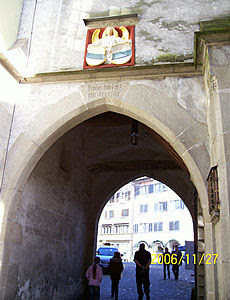
The story tells of how watchmen, holed up in the tower night after night, used to complain of the fat, long-tailed rats that scampered around them and stole their food. No way could be found to keep the rats away until a foreign scholar, passing through Zug on his way to Salerno, heard of the problem and advised the watchmen to paint a big, fat rat on the wall where the creatures got into the watch rooms. They did so, and the following night, when the rats appeared again, the watchmen saw them catch sight of the painting, sniff around it, and flee in fear. The painting stayed, and rats never plagued the Zytturm again.
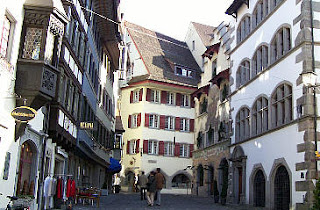
Heading beneath the Zytturm brings you into the most atmospheric part of the Old Town with cobbled lanes lined with medieval gabled and balconied (and often frescoed) houses.


Intricate wrought iron signs proclaim the whereabouts of shops. We can only guess that "Zumhecht" must be the name of a fishmonger.
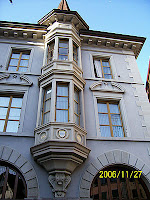
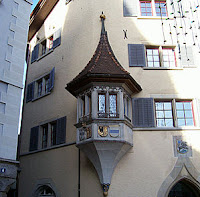
The architecture of the buildings in the Old Town is fascinating. The projecting bay windows add heaps of character to the facades.

Another surprise the tourist often finds waiting around the corner is one of Zug's many bronze statues, some combined with fountains. This one of the boy with the fish seems of modern manufacture and purely decorative, but the most fascinating statue we came across was this one of the old woman carrying her husband in a basket on her back. She became tired of him always being drunk at the bar, so she piled him into the basket and carried him off home. It is quite clear that he is very intoxicated, singing merrily all the way, but what a brave (and strong) woman she was!
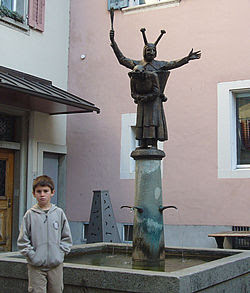


This timber-clad building was not all that common in the Zug Old Town, but is very typically Swiss, complete with flower boxes filled with blooming Geraniums.
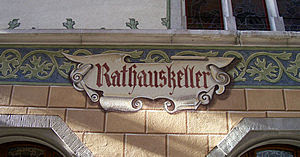
Just behind the Zytturm is Zug's Rathaus, dating from 1509 and retaining much of its original woodwork, and a few steps north is the waterside Landsgemeindeplatz with its Swan statue.

We have come full circle back to the waterfront.
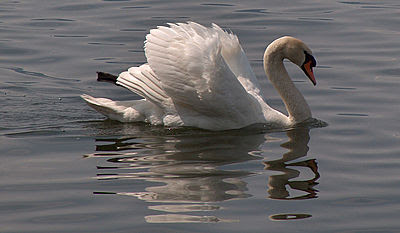
The white swans of Switzerland are beautiful, especially in our eyes, as we are from New Zealand where the swans are all black.

The view over the lake was magically misty.
Lake Zug (German: Zugersee) has an area of 38.3 square km and has a maximum depth of 200 m. Toward the south-west extremity of the lake the Rigi descends rather steeply to the water's edge. The titanic chunk of the Rigi, which rises to 1798 m, lies between the lakes of Lucerne and Zug, and has long been famous as a majestic viewpoint. It divides the two lakes, and is also called the "Queen of the Mountains".
Zug is famous for its cherries, which are processed into many varieties of local Kirsch (cherry brandy) and made into Zuger Kirschtorte, a delectably buttery almond tart saturated with Kirsch, but that does not have a single fruit adorning it. Sadly, we missed the opportunity to taste the Kirschtorte.

1 comment:
Great post and nice reading
I went to Zug as intermediate stop without nothing to expect, but it turned out to be a beautiful city.
As we didn't read Zug city guides prior this visit, Zug was only observed in its old town and lake beauty. Now I know the history :)
Post a Comment